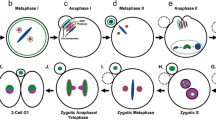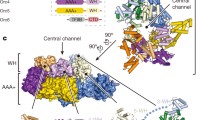Abstract
THE six-subunit origin recognition complex (ORC) is essential for the initiation of DNA replication at specific origins in the budding yeast Saccharomyces cerevisiae1–9. An important issue is whether DNA replication in higher eukaryotes, in which the characteristics of replication origins are poorly defined10, occurs by an ORC-dependent mechanism. We have identified a Xenopus laevis Orel-related protein (XORC2) by its ability to rescue a mitotic-catastrophe mutant of the fission yeast Schizosaccharomyces pombe. We show that immunodepletion of XORC2 from Xenopus egg extracts11–13 abolishes the replication of chromosomal DNA but not elongation synthesis on a single-stranded DNA template. Indirect immunofluorescence indicates that XORC2 binds to chromatin well before the commencement of DNA synthesis, and even under conditions that prevent the association of replication licensing factor(s) with the DNA. These findings suggest that Orc2 plays an important role at an early step of chromosomal replication in animal cells.
Similar content being viewed by others
References
Bell, S. P. & Stillman, B. Nature 357, 128–134 (1992).
Diffley, J. F. X. & Cocker, J. H. Nature 357, 169–172 (1992).
Bell, S. P., Kobayashi, R. & Stillman, B. Science 262, 1844–1849 (1993).
Foss, M., McNally, F. J., Laurenson, P. & Rine, J. Science 262, 1838–1843 (1993).
Micklem, G., Rowley, A., Harwood, J., Nasmyth, K. & Diffley, J. F. X. Nature 366, 87–89 (1993).
Li, J. J. & Herskowitz, I. Science 262, 1870–1874 (1993).
Diffley, J. F. X., Cocker, J. H., Dowell, S. J. & Rowley, A. Cell 78, 303–316 (1994).
Fox, C. A., Loo, S., Dillin, A. & Rine, J. Genes Dev. 9, 911–924 (1995).
Liang, C., Weinreich, M. & Stillman, B. Cell 81, 667–676 (1995).
Coverley, D. & Laskey, R. A. A. Rev. Biochem. 63, 745–776 (1994).
Blow, J. J. & Laskey, R. A. Cell 47, 577–587 (1986).
Newport, J. Cell 48, 205–217 (1987).
Adachi, Y. & Laemmli, U. K. EMBO J. 13, 4153–4164 (1994).
Lundgren, K. et al. Cell 64, 1111–1122 (1991).
Russell, P. & Nurse, P. Cell 49, 559–567 (1987).
Zuber, M., Yasui, W., Tan, E. M. & Ryoji, M. Expl Cell Res. 182, 384–393 (1989).
Méchali, M. & Harland, R. M. Cell 30, 93–101 (1982).
Kornbluth, S., Smythe, C. & Newport, J. W. Molec. cell. Biol. 12, 3216–3223 (1992).
Fang, F. & Newport, J. W. J. Cell Sci. 106, 983–994 (1993).
Chong, J. P. J., Mahbubani, H. M., Khoo, C.-Y. & Blow, J. J. Nature 375, 418–421 (1995).
Kubota, Y., Mimura, S., Nishimoto, S. I., Takisawa, H. & Nojima, H. Cell 81, 601–609 (1995).
Madine, M. A., Khoo, C.-Y., Mills, A. D. & Laskey, R. A. Nature 375, 421–424 (1995).
Dasso, M. & Newport, J. W. Cell 61, 811–823 (1990).
Mueller, P. R., Coleman, T. R. & Dunphy, W. G. Molec. Biol. Cell 6, 119–134 (1995).
Maundrell, K. J. biol. Chem. 265, 10857–10864 (1990).
Moreno, S., Klar, A. & Nurse, P. Meth. Enzym. 194, 795 (1991).
Allshire, R. C. Proc natn. Acad. Sci. U.S.A. 87, 4043–4047 (1990).
Kumagai, A. & Dunphy, W. G. Molec. Biol. Cell 6, 199–213 (1995).
Yan, H. & Newport, J. J. Cell Biol. 129, 1–15 (1995).
Mills, A. D. et al. J. Cell Sci. 94, 471–477 (1989).
Author information
Authors and Affiliations
Rights and permissions
About this article
Cite this article
Carpenter, P., Mueller, P. & Dunphy, W. Role for a Xenopus Orc2-related protein in controlling DNA replication. Nature 379, 357–360 (1996). https://doi.org/10.1038/379357a0
Received:
Accepted:
Issue Date:
DOI: https://doi.org/10.1038/379357a0
- Springer Nature Limited
This article is cited by
-
ORC proteins in the mammalian zygote
Cell and Tissue Research (2016)
-
The Xenopus Cell Cycle: An Overview
Molecular Biotechnology (2008)
-
Specification of a DNA replication origin by a transcription complex
Nature Cell Biology (2004)
-
Human Orc2 localizes to centrosomes, centromeres and heterochromatin during chromosome inheritance
The EMBO Journal (2004)
-
Triggering ubiquitination of a CDK inhibitor at origins of DNA replication
Nature Cell Biology (2001)





